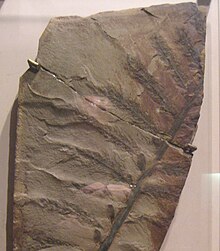| Archaeopteris Temporal range:
| |
|---|---|

| |
| Archaeopteris hibernica | |
| Scientific classification | |
| Kingdom: | Plantae |
| Clade: | Tracheophytes |
| Class: | †Progymnospermopsida |
| Order: | †Archaeopteridales |
| Family: | †Archaeopteridaceae |
| Genus: | †Archaeopteris Dawson (1871) |
| Species | |
| |
Archaeopteris is an extinct genus of progymnosperm tree with fern-like leaves. A useful index fossil, this tree is found in strata dating from the Upper Devonian to Lower Carboniferous (383 to 323 million years ago), the oldest fossils being 385 million years old,[1] and had global distribution.
Until the 2007 discovery of Wattieza, many scientists considered Archaeopteris to be the earliest known tree. Bearing buds, reinforced branch joints, and branched trunks similar to today's woody plants, it is more reminiscent of modern seed-bearing trees than other spore-bearing taxa. It combines characteristics of woody trees and herbaceous ferns, and belongs to the progymnosperms, a group of extinct plants more closely related to seed plants than to ferns, but unlike seed plants, reproducing using spores like ferns.

